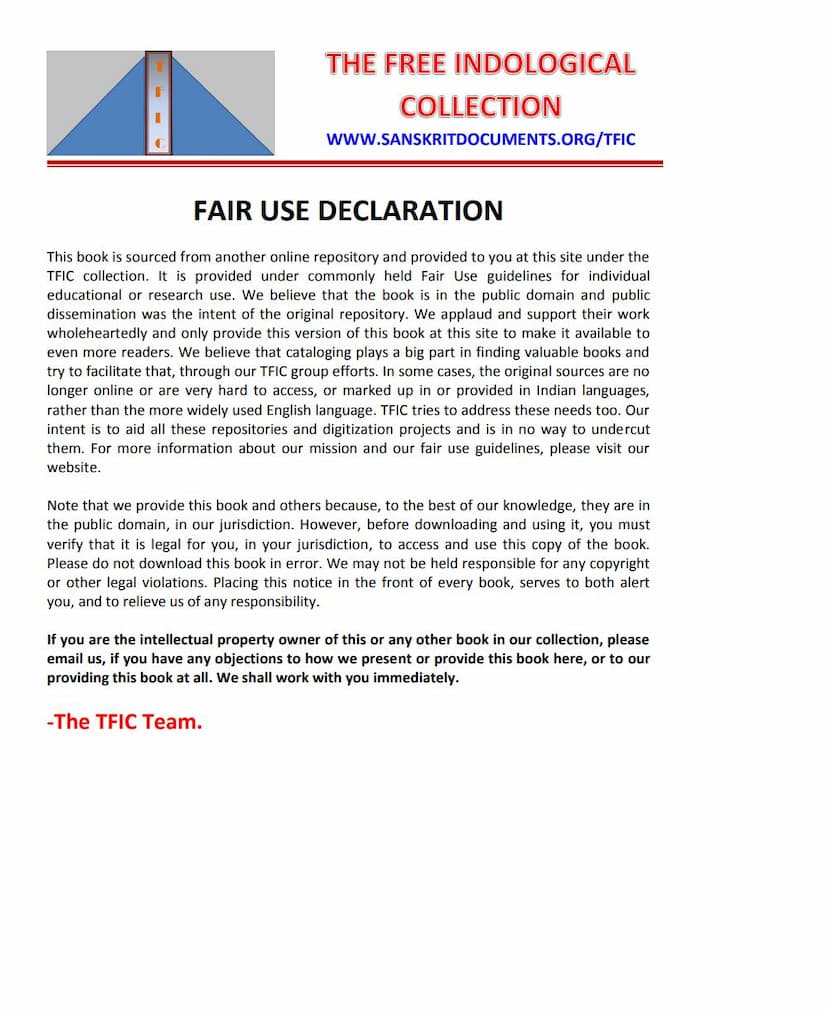Paniniyasutra Pathasya
Added to library: September 2, 2025

Summary
This is a comprehensive summary of the provided Jain text, "Paniniyasutra Pathasya" by Siddheshwar Shastri, published by the Bhandarkar Oriental Research Institute in 1935. The summary focuses on the content and structure of the book as indicated by the table of contents and the sample pages.
Book Title: Paniniyasutra Pathasya Author: Siddheshwar Shastri Publisher: Bhandarkar Oriental Research Institute, Poona Year of Publication: 1935 Catalog Link: https://jainqq.org/explore/010557/1
Comprehensive Summary:
The book "Paniniyasutra Pathasya" by Siddheshwar Shastri is a monumental work published by the Bhandarkar Oriental Research Institute in Poona in 1935. As the title suggests and the table of contents confirms, this volume is dedicated to providing a comprehensive word index and patha (textual reconstruction) for Panini's foundational grammatical work, the Ashtadhyayi, along with its associated Parisistas (supplementary texts). The publication aims to be a crucial resource for scholars and students of Sanskrit grammar, particularly for understanding the textual variations and the intricate vocabulary within Panini's grammatical system.
The book is meticulously structured, offering a word index for various key texts related to Paninian grammar. Based on the detailed index provided, the book covers the following sections:
-
Ashtadhyayi Sutra Patha (with Varttika Patha): This is the core of the work, presenting the textual reconstruction of the Ashtadhyayi sutras, critically edited with a parallel path of Katyayana's Varttikas. It also includes a discussion of variant readings, making it a valuable tool for textual criticism.
-
Parisista Varttikani (as cited by Kaiyata): This section likely provides a compilation of Varttikas as referenced by the commentator Kaiyata in his Mahabhashya, offering insights into the debates and elaborations on Panini's sutras.
-
Dhatupatha: A comprehensive index of Sanskrit roots, including their grammatical features such as conjugation class (gana), conjugation type (parasmapada/atmanepada), and whether they are set (with an affix), vet (without an affix), or anit (without a particular affix).
-
Ganapatha: A detailed index of the ganas (classes or groups of roots) mentioned in Panini's grammar, likely presented in alphabetical order for ease of reference, and cross-referenced with the Ashtadhyayi sutras.
-
Varttikashtha Ganapatha: This section specifically indexes the ganas mentioned in Katyayana's Varttikas, highlighting their importance in understanding the grammatical tradition.
-
Antarganasutrani (in alphabetical order): This refers to the sutras that define the ganas, presented alphabetically with their locational references within the texts.
-
Lingānusāśana Shabda Kosha: A word index for the Lingānusāśana, a text that deals with grammatical gender, a crucial aspect of Sanskrit morphology.
-
Shakatāyana Sadhitāh Shabdah: This section likely indexes words and grammatical concepts as derived or explained by the ancient grammarian Shakatāyana, perhaps focusing on his Shakatāyana Shabdanushasana.
-
Phitsutra Shabda Patha: An index to the Phitsutras, a set of aphorisms that deal with the accentuation and phonetic changes of words, particularly in Vedic texts.
-
Parishishta: This is a general term for supplementary texts. It includes abbreviations used throughout the work, a list of corrections (shuddhipatra), and potentially other relevant materials for understanding the primary texts.
Key Methodological Aspects:
The introductory sections (Prastavika) highlight the compiler's approach, emphasizing:
- Adherence to established texts: The work acknowledges and follows various standard editions of Panini's Ashtadhyayi, Varttikas, and other relevant grammatical literature, such as the Kashika Vritti, Balmanorama, Uṇadi Sutras, and works by scholars like Kielhorn and Böhtlingk.
- Compilation and Cross-referencing: The book's primary aim is to compile and index terms from these various sources, providing clear references to the chapters, verses (sutras), and sometimes even specific parts of the texts.
- Critical Approach: The compilers have taken care to present variant readings (pathabheda) in footnotes or specific notations, acknowledging the nature of classical Sanskrit texts which often have multiple recensions.
- Linguistic Detail: For roots (dhatus), the index provides information on their class, the type of conjugation (parasmaipada/atmanepada), and whether they are set (with a specific affix), veṭ (without a particular affix), or aṇit (without a specific affix).
- Composite Word Analysis: In the case of compound words (samāsāntas), the index details how they are broken down, especially for dvandva compounds, using specific symbols to denote the first and second parts.
- Symbolic Notation: The book utilizes specific symbols, the meaning of which is explained in an appendix (Parishishta), to represent various grammatical features and concepts.
- Language Accessibility: While the original texts are in Sanskrit, the compilers aim to make this index accessible to a wider scholarly audience, possibly by providing context or explanations where needed, although the primary focus remains on the Sanskrit terminology itself.
Overall Significance:
"Paniniyasutra Pathasya" serves as a foundational reference work for anyone engaged in serious study of Panini's grammar. It offers an unparalleled level of detail in indexing the vast lexicon and grammatical structures embedded within the Ashtadhyayi and its related literature. The meticulous compilation by Siddheshwar Shastri and the support of the Bhandarkar Oriental Research Institute have resulted in a scholarly achievement that has likely facilitated generations of research in historical linguistics, Sanskrit philology, and Indian intellectual history. The book's commitment to providing textual variations and detailed cross-references makes it an indispensable tool for authenticating and understanding Panini's unparalleled grammatical system.